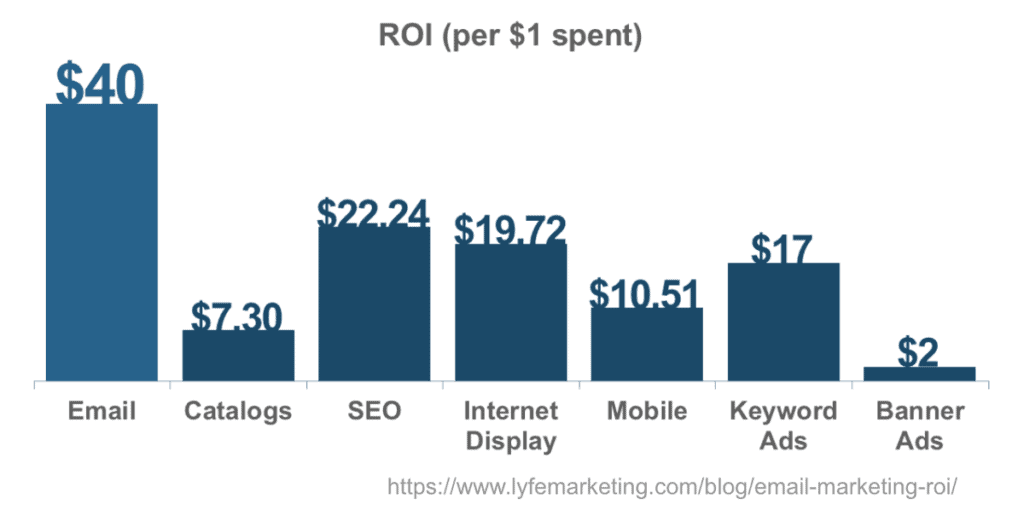How to Make an Authentic Marketing Strategy
We’ve been helping businesses become more profitable for over 20 years. And we’ve had our fair share of experience with different marketing strategies.
Many companies have a vision for the type of business they want to have in the future. While it’s important to know your company’s direction, it’s also crucial to know where you’re heading first. This is especially true for companies trying to build a brand in a new industry or niche.
If you’re successful in this new industry or niche, you will have to build a brand that appeals to the new clientele.
This post will guide you through all the stages of planning your approach, including a step-by-step blueprint for how to make an authentic marketing strategy.
Table of Contents
What is an Authentic Marketing Strategy?

While authenticity can apply to almost any marketing strategy, it refers specifically to how marketers communicate with customers when applied to marketing.
A robust and authentic marketing strategy makes customers feel like they are being treated as individuals who matter, rather than just another number in a massive database.
The most successful marketing strategies combine an understanding of the customer’s needs and wants with the ability to connect to them emotionally, through advertising, and through everything a company does, from website design to their products.
According to an article written by marketing professor David B. Holtz, an authentic marketing strategy is a “strategy that is consistent with the brand’s stated identity, and that fits the company’s culture.”
Authenticity is the key. An authentic marketing strategy incorporates the brand’s culture and values into every aspect of its advertising and marketing communications, from the copy of the website to the look and feel of the physical store.
If a marketing strategy doesn’t align with the brand’s culture and values, it will seem forced, artificial, and inauthentic.
Why Is This Important?
This question is the most important you can ask yourself as a marketer. Authenticity is the basis of all marketing. Without it, there is no differentiation.
Consumers today have become more intelligent than ever and have access to far more information than they did in the past. This means that consumers are more aware of what they need and don’t need.
When marketers are authentic, they create trust with consumers and allow them to see them as someone they want to do business with.
Marketers can learn a lot from the science of behavioural psychology. One thing that behavioural psychologists have learned is that humans are hardwired to follow authority.
We tend to obey people who seem more legitimate and authoritative than ourselves, and we are less likely to follow people who seem less competent.
People hate being sold to, yet most of us still buy products. One reason for this is that we don’t feel like we have a choice. We don’t want to feel like we’re being manipulated. If you want to be successful as a marketer, the first thing you need to do is to show people you’re genuinely interested in helping them. Do that, and you’ll create trust.
15 Steps to Creating an Authentic Marketing Strategy
1 – Find out whom you are going after

While it may seem like a no-brainer to market to the kind of people you want to attract to your business, you’d be surprised by how many businesses don’t take the time to figure that out.
“If you don’t know what kind of customers you’re looking for, you’re going after the wrong ones,” says Mike Nieporent, founder of CreativeLive. “Start thinking about the customer profile you want, and then figure out whom you will get to your business.”
For example, if you’re launching a site to help small businesses sell their products online, you should start with people who fit the bill: people who run their businesses and aren’t likely to jump at something new. Or maybe you’re planning to grow your email list and reach out to subscribers who will be interested in the kinds of products or services you sell.
2 – List all of your objectives
A common mistake that businesses make in their marketing is to use marketing messages that are not authentic. An authentic message comes straight from you. It reflects what you truly believe. Authentic messaging is often used in direct response marketing and content marketing.
Marketing is a lot about setting goals. And goals are set for a reason. They usually support an outcome, whether revenue, sales, leads, awareness, etc. So the real question here is, why are you setting this particular goal?
If you’re setting a goal because you feel like you have to or because someone told you you had to, then there is a good chance you will have a hard time reaching it.
3 – Know what you want your website to look like

People want to trust those who are trustworthy. The second most important factor in whether or not a potential customer chooses to buy from you is whether or not they like and trust you.
If your website isn’t making a positive impression on your target audience, you don’t need to worry about convincing people to buy from you. So, the key is not to focus on getting conversions from your website. Instead, focus on getting people to trust you and your business.
4 – Identify and target your audience
Once you’ve figured out whom you’re trying to sell to, your next challenge is figuring out who they are.
- Do they shop online?
- How do they search for products online?
- Where do they turn when they’re ready to buy?
- Which online channels are they using?
The first step in figuring out who your ideal customers are is to identify where they are in their buying journey and what channel they’re using to research your brand. From there, you can create a customised experience for each segment.
What if we told you that marketing messages tailored specifically to you as a consumer are more effective than generic ones? The concept seems simple, but it’s one of the most fundamental marketing concepts. Marketers should not waste their time reaching every consumer but instead focus their efforts on the consumers who are most likely to buy.
5 – Identify and study your competition
You may want to look at what your competitors are doing and why. What makes them stand out from the crowd? Is it because they’re offering a better price or because they’re offering more?
In a recent report published by the Harvard Business Review, researchers suggest that the unique value propositions drive growth. By studying your competition and their customers, you can learn what they are good at and what they aren’t so good at. You can also learn which areas you should focus on and shouldn’t.
6 – Know your budget

Knowing your marketing budget allows you to manage expectations for the amount of money you can spend. It’s important to remember that marketing is just one part of the equation, and if you overspend on marketing, you could spend more than you planned.
Whether you’re advertising on Facebook or Instagram or sending emails, your spending on marketing impacts the return on your investment (ROI).
You should set up your campaign to achieve your business goals and determine your ROI, not just because you have to do it but because it gives you a baseline to measure future performance.
7 – Choose a theme or message
What do you want to communicate about yourself as a business owner? What does that say about your business? Do you want to emphasise your expertise? Do you want to emphasise how easy it is to use your services?
Whatever you want to communicate about yourself and your company, please choose one or two key messages and stick to them. Don’t be too specific—be general, and your audience will quickly connect the dots.
This question lets you know exactly what you want to communicate to your audience. If your purpose is to sell something, it should be crystal clear to you. But if you’re trying to tell your story or share a bit of yourself with your readers, you need to decide on a theme or message that will help guide an authentic marketing strategy.
8 – Build your marketing strategy
One of the best ways to build trust with your customers is to prove yourself by telling them something honest about yourself. This is especially true if you’re a brand that markets to younger consumers.
You’ll want to make sure that your company is transparent and open about your business. You’ll want to show your face and tell your story. People will start to feel a greater connection with you when you do.
Authenticity in marketing is something people can smell from a mile away. Even if you’re able to convince someone to trust you, if you’re not being authentic about your company, you’re likely to end up losing customers (and potentially your brand) very quickly.
9 – Do your research

For example, if you’re looking to sell shoes, don’t just copy the Nike model. Instead, do some research, find an example of successful marketing in your category, and figure out how it differs from the norm. The more information you have, the better you’ll be at crafting your compelling marketing message.
To truly understand a persuasive message, you need to understand why the message is being sent. To do this, it’s essential to see past the surface message of the ad, ad copy, or sales presentation.
Understanding the psychology behind why the company uses marketing as a form of advertising is the first step toward understanding its goals and motivations.
10 – Develop a plan
Once you have a clear sense of your customers and know who they are and what they’re looking for, it’s time to put the pieces together to develop a marketing strategy that’ll help you hit your business goals.
As you plan, keep in mind that your audience is constantly evolving, and your goals change as you gain experience and expertise in your field. You’ll be fine if you’re willing to adapt and evolve with your company.
11 – Set up a landing page
When it comes to marketing, setting up a landing page is one of the easiest and most cost-effective ways to get your business found online. It takes minimal effort to set up, and once you’re done, you’re ready to start promoting your business online.
The goal of a landing page is to give visitors what they want (in this case, your offer) and move them along to the next step. Think of it as a pre-order form for your product or service. Once a visitor fills out the form and submits it, you’ll receive an email confirming their interest.
12 – Build a list of subscribers

What’s the point of getting many people interested in your business if you don’t have any leads? The problem is that many business owners wait too long to build a list.
They start the process thinking that everyone wants to sign up for their newsletter or join their Facebook group, but then it becomes clear that this isn’t true, and they have no one to send the marketing material to. By building a list of subscribers, you get a highly engaged audience with your business.
When I started the business, I was trying to reach my goals through social media. But what I noticed is that many people don’t really like to comment on the content or even share it. So I decided to build a list of subscribers. When someone comments on my posts, they get emails from me with some tips.
13 – Launch your Marketing Campaign
After you’ve figured out your audience, you need to figure out what message you want to convey. Here’s the rule: Don’t waste your time telling your audience what you think they should do.
Instead, show them how to do it. And when you do this, make sure that the way you show them how to do it is authentic.
When marketing, the most challenging hurdle you’ll face is building credibility and trustworthiness with your target audience. If you start by talking about your company, you immediately limit your audience to those who already know who you are. If you’re not careful, your efforts will quickly fall flat.
14 – Make your first sale
Achieving that first sale can be an intimidating challenge for new entrepreneurs. They may feel overwhelmed and not know what they are doing. But if you approach selling as a marketing campaign, it will be easier to manage the process.
Think of it like this: When you make a big splash in your marketing, you are trying to attract potential customers, but you are also announcing that your product exists and is ready to sell.
15 – Measure your success

Marketing is a long-term strategy that you should never take lightly. Developing a winning campaign takes time and effort, but seeing measurable results is worth it.
One standard measurement for the success of a marketing campaign is clickthrough rates. Clickthrough rate (CTR) is the percentage of people who click through your site after viewing one of your ads.
If you’re running a Facebook ad campaign, you’ll want to look for conversions, such as email signups or sales. These are two good metrics to keep track of.
So you have a marketing strategy, but how do you know if you’re measuring its effectiveness?
Question the following:
- How much money did you spend?
- How much did you achieve?
- How many new customers did you acquire?
- What are your top and bottom line conversion rates?
- Do you know how much revenue you’re generating?
- Do you know what’s working and what isn’t?
- Is your business profitable?
- Have you done enough testing?
- Can you measure your ROI?
- Are you meeting your goals?
- Are you growing?
- Can you repeat your strategy?
- Is your strategy scalable?
- Is your strategy aligned with your business model?
Conclusion
An authentic marketing strategy is based on solid research and tested theories. If you’re looking for a marketing strategy that will deliver results, you need to work closely with the right marketing experts.
To create a powerful authentic marketing strategy, you must know who your audience is, what motivates them, and how to make their lives better.
This information will help you decide where to place your marketing dollars and what type of advertising works best for your target market. To help you achieve this, follow the steps above to help you put your ideas into action.
This is not just another marketing strategy; it’s a way of life.
